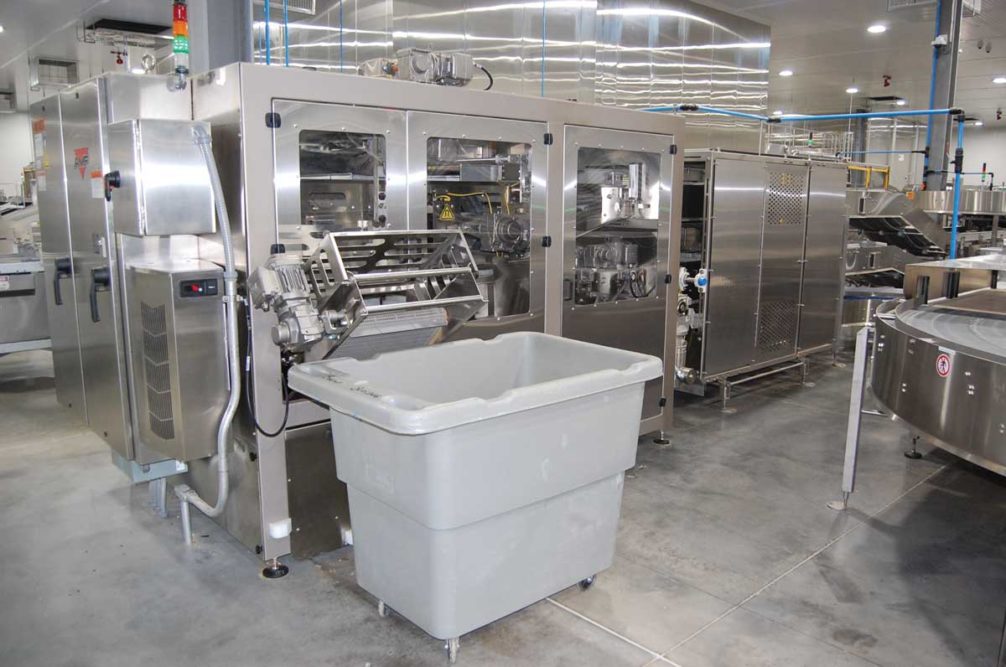Because of allergens and other food safety concerns, pan cleaning has become a higher priority, even on bread and bun lines, with the variety seeds and glazes that are applied to products.
“A good pan cleaner should mechanically brush the pan hard enough to remove excess material while not damaging the surface of the pan,” observed Mike Scouten, vice president of sales and marketing, Stewart Systems and Baker Thermal, both Middleby Bakery companies.
“And an air knife and vacuum coupled with the brush are needed to remove all the loosened debris,” he continued. “The sprayed-on glazes do build up over time, and while a good portion of this can be removed mechanically, not all of it can. As a result, this is currently the main driver in the number of cycles a baker can use these pans between needing to be recoated.”
Bundy Baking Solutions is developing a new pan cleaner with FME Food Machinery Engineering Ltd. to help clean the pans without damaging the coating. The company provides tips for protecting coatings, such as avoiding exposure to hot steam or too much moisture for prolonged periods, using detergents in low concentration, if necessary, and drying properly after washing, said Trevor Walker, vice president of North American sales, Bundy Baking Solutions.
Such common practices also are incorporated into most cleaning systems.
“Today’s pan-washing systems offer temperature adjustments to allow for detergents that activate and clean at lower temperature levels,” said Kevin Quinn, sales manager, Douglas Machines Corp. “Using lower wash temperatures can save expensive coatings on pans.”
He added that Douglas’ washer line provides for a sanitizing rinse using hot water rather than chemical sanitation, which reduces cost on chemicals and exposure of multiple chemicals on the pans.
The Food Safety Modernization Act played a major role in upgrading cleaning procedures in recent years.
“Recirculated wash systems have replaced the hose or pressure washer, which send water down the floor drain,” Mr. Quinn explained. “Continuous motion tunnel washers are now designed with multiple recirculated tanks so that the final sanitizing rinse water consumption can be reduced by as much as 70% over conventional designs.”
In bread and bun bakeries, seeds and toppings remain a primary culprit for cleaning and allergen control.
“Pans for cakes and muffins are best cleaned using a pan washer to remove the sugar and fat content,” noted Bruce Campbell, vice president of dough processing technologies, AMF Bakery Systems. “Doing this can extend the life of pan coatings by 10% to 15%.”
Mr. Quinn said the Douglas tunnel washer can be customized to provide high processing speeds for sheet and muffin pan lines.
“Our tunnel washers can be used out-of-line with operators at each end,” he said. “Or they can be designed for in-line operation by accepting pans from a depanning device into the washer and then out to an exit conveyor to be returned to the baking operation.”
To dry-clean pans on high-speed lines, AMF bun and bread pan cleaners use dry brushes and gravity by inverting the pans and ambient air blowers to remove crumbs and topping debris stuck in them.
“This reduces the impact of burning the leftover crumbs which tends to generate extra heat and damage the pan glazing material,” said Bobby Martin, executive product manager, AMF. “Bread loaves left in pans will result in crooked stacks with the risk of tilting over as well as pans being stuck together at the unstacker.”
Overall, bakers need to consider all costs by calculating the economics of the coatings vs. the value obtained from them, said Mr. Walker.
“Factors including proximity to a recoating facility, use of release agents, along with baking temperature, pan-handling practices and cleaning are important in determining the right type of coating,” he said.
And don’t forget to include overall pan operations as part of the company’s broader environmental program.
“Today’s pan coatings are helping bakeries be more sustainable because of their longer usage cycles and comprehensive service,” Mr. Walter said. “Easy and consistent release of products means fewer cripples and bakery waste.”
Paying close attention to the finest details can uncover new roads to profitability as bakeries test the limits of working in the fast lane.
This article is an excerpt from the February 2020 issue of Baking & Snack. To read the entire feature on pan glazing, click here.





